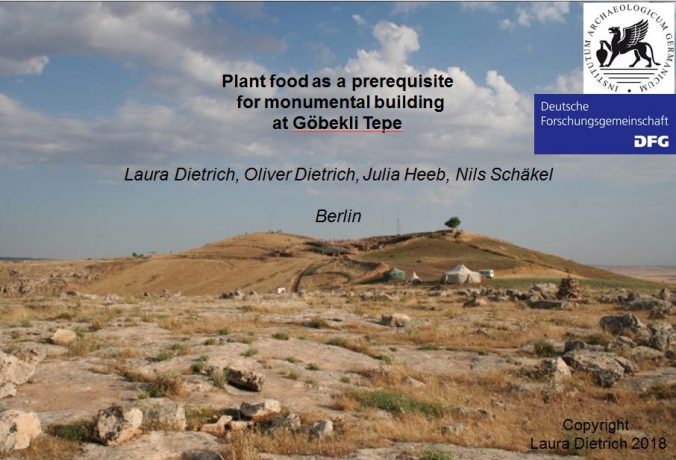Plant food is a factor so far slightly neglected in research about Göbekli Tepe. We are now aiming to close this gap [read more here and here]. Preliminary results on grinding equipment from Göbekli Tepe and experimental approaches will be presented at this year´s Awrana (Association of Archaeological Wear and Residue Analysts, external link) conference at University of Nice Côte d’Azur on May 31, in a collaborative paper by Laura Dietrich, Oliver Dietrich, Julia Heeb and Nils Schäkel.
Abstract:
During the 10th and 9th millennia BC, at Göbekli Tepe in southeastern Anatolia, hunter-gatherers constructed the first monumental architecture of mankind. In an older phase, circular enclosures made up of up to 5.5m high pillars decorated richly, mainly with animal motifs, were erected, while in a younger phase rectangular buildings with smaller pillars were in use. Important questions regarding this site concern the way in which small-scale groups joined their forces for the massive construction work, creating a place strongly connected to their worldview, and how they secured their subsistence during the prolonged work at the site.
Until now, the focus was on the numerous finds of animal bones and hunting as subsistence strategy. This image may be biased by bad preservation conditions for plant remains, as more than 10.000 grinding stone were discovered at the site, reaching from flat slabs over deep bowls to mortars, pestles and handstones. At least in the younger phase of the site, a number of the square rooms could be interpreted as storage facilities, as they also contain large limestone vessels with capacities of up to 200 liters. Macroscopic and microscopic use wear hint at the use of the grinding stones for massive plant food processing. This interpretation is based on a comparison with experimentally manufactured objects. During the experiments, use-wear was related to shapes and to the grinding motions as important analytical parameters.
The paper aims to reveal the role of plant food at Göbekli Tepe, and linked with this, economic and social factors related to the construction and maintenance of this important site.

Fascinating. This research may help archaeologists around the world.
Re: The grinding stones that were discovered—were these usually deliberately formed into definite shapes (such as the rectangular prism handstone depicted in Figure 4 of the 9/23/17 Tepe Telegrams), or is there more evidence suggesting that the forms were natural?
Thank you for your comment. All handstones were deliberately formed.
Hi Laura,
Where can I read the full paper?
best,
STEF
The paper is in preparation. Thank you for your interest.
Tks Laura.. I look forward to it. Please can you tell me if the various plants/seeds used fall into any specific plant-harvest annual timeframe e.g. late summer / autumn?
Also waiting for your full paper!
Are there already estimations / simulations of the workload – maybe in men years – which was needed to build Tepe?
On your specific work here could you also estimate / simulate how many human beings the griding hand-stones would have been able to feed ?
How good do these two estimations fit together?
Were the hand-stones already present at the early stages of Tepe ?
Kind regards,
Michel
e.g. most seeds would be ready to harvest in spring or autumn.. but not all – Is that right?